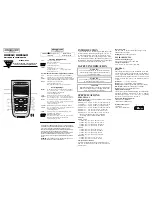
TB7300 SERIES COMMUNICATING FAN COIL THERMOSTATS
15
62-2018—05
Channel
Channel selection
Default value =
10
Set to:
15
or
25
Range is: 10 to 26
Conditional parameter to wireless models (TB73xxX5x14W)
This parameter will only appear when a wireless network adapter is
present. If the thermostat is installed as a stand-alone unit or is a
BACnet model, this parameter will not be used or displayed
This parameter (Channel) is used to link specific thermostats to a
specific WEBs controller with a wireless communication card. For
every thermostat reporting to a gateway (maximum of 30
thermostats per WEB-2xx controller and 50 thermostats per WEB-
6xx/-7xx controller) be sure you set the
SAME
channel value both at
the wireless communication card and the thermostat(s).
Honeywell recommends using only the channels 15 (2425 MHz)
or 25 (2575 MHz).
The default value of 10 is
NOT
a valid channel. Although the valid
range of available channels is from 11 to 26 use only channel 15 or
25 to avoid interference with other wireless devices.
Get From
Default value =
255
Range is: 0-254
Conditional parameter to wireless models (TB73xxX5x14W)
This parameter is only available for wireless thermostats. This
parameter lets you to copy the configuration parameter settings from
a like Honeywell TB7200 thermostat. To use this command, the
thermostat you want to copy parameters from must be on the
wireless network with a network address (
Com addr
) and must be
the same model number as the thermostat you want to copy to.
On the thermostat you want to copy parameters to, enter the network
address (
Com addr
) of the thermostat you want to copy parameters
from. This process can be completed locally at the thermostat or
using the WEBStation-AX.
If the parameters copy successfully, the
Get From
address returns to
255
. If the parameters do not copy successfully,
254
is displayed. If
the copy was not successful, verify the following:
•
The thermostat to be copied is the same model as the one being
copied to.
•
The thermostat to be copied is on the network.
•
The correct network address (
Com addr
) value for the thermostat
to be copied was entered.
Leaving the
Get From
parameter value at
255
means that
configuration parameters will be set manually.
BI1
Binary input no.1 configuration
Default value
=
None
(None):
No function will be associated with the input
(Rem NSB):
remote NSB timer clock input. The scheduling will now
be set as per the binary input. It provides low cost setback operation
via a dry contact
•
Contact opened = Occupied
•
Contact closed = Unoccupied
(Motion NO) or (Motion NC):
Advanced PIR occupancy functions
using a Normally Open (NO) or Normally Closed (NC) remote PIR
motion sensor. Occupancy mode is now set as per applied PIR
function and configuration.
Application information is available in the PIR Application Guide for
TB7300 Series Thermostats (Form No. 63-4526). This document
provides installers and system designers with detailed examples on
applications, parameter configuration, sequence of operations,
troubleshooting and diagnostic help required for proper use of
occupancy sensor models.
(Window)
EMS: Forces the system to disable any current heating or
cooling action by the thermostat. The mode stays the same and the
current setpoints are the same Occupied setpoints. Only the outputs
are disabled. There is a Door/Window alarm displayed on the
thermostat to indicate to the local tenant that the door/window needs
to be closed for cooling or heating to resume.
NOTE: These settings will disable the local override function
on the thermostat.
Table 11. Configuration parameters
Configuration
parameters
Default value
Significance and adjustments










































